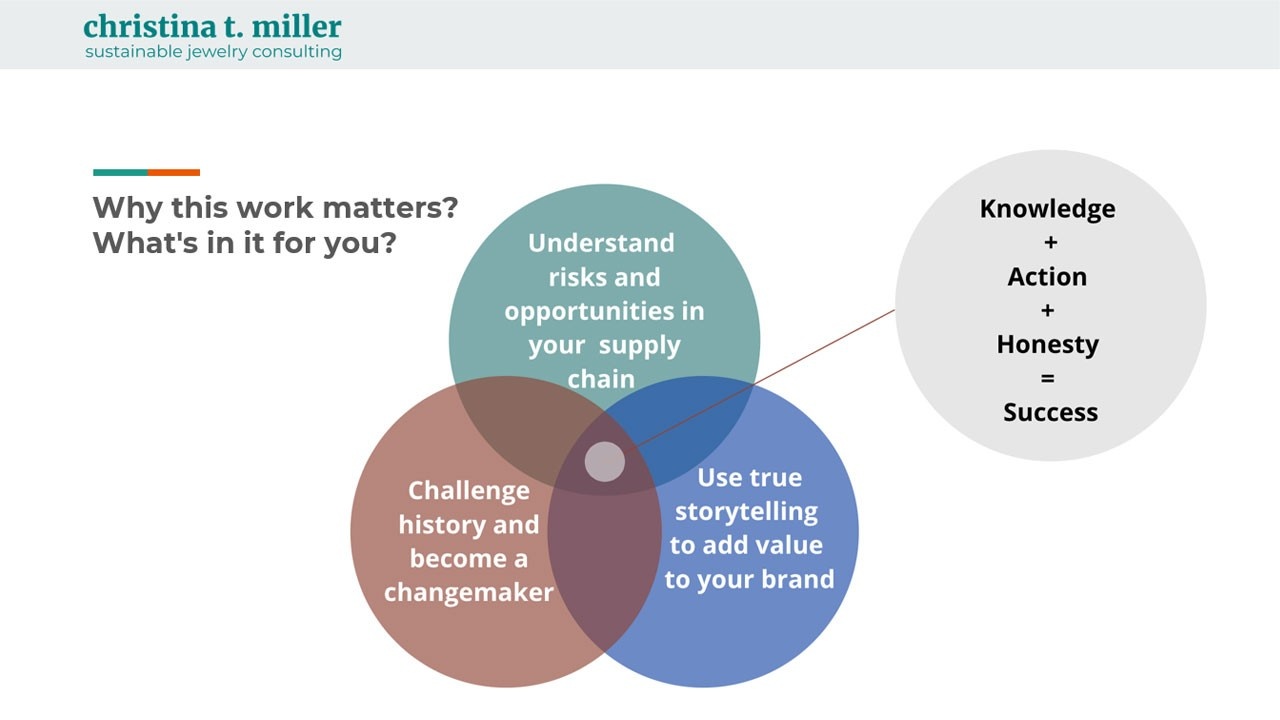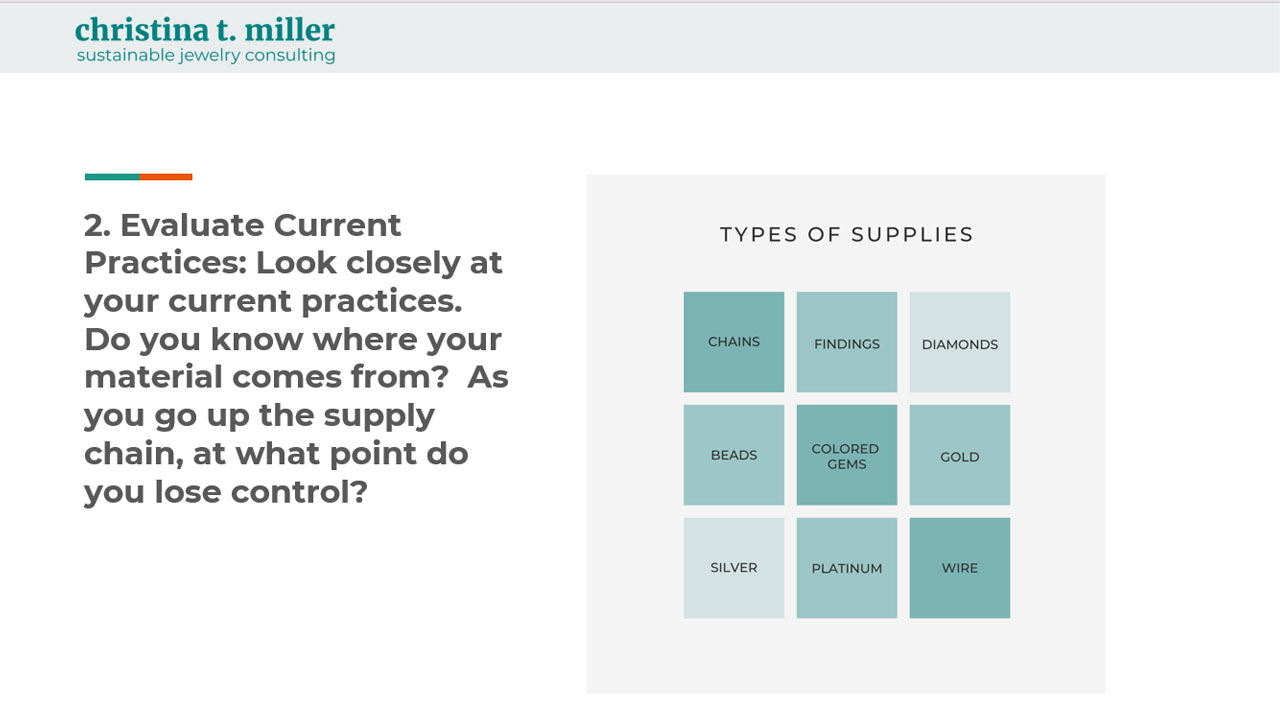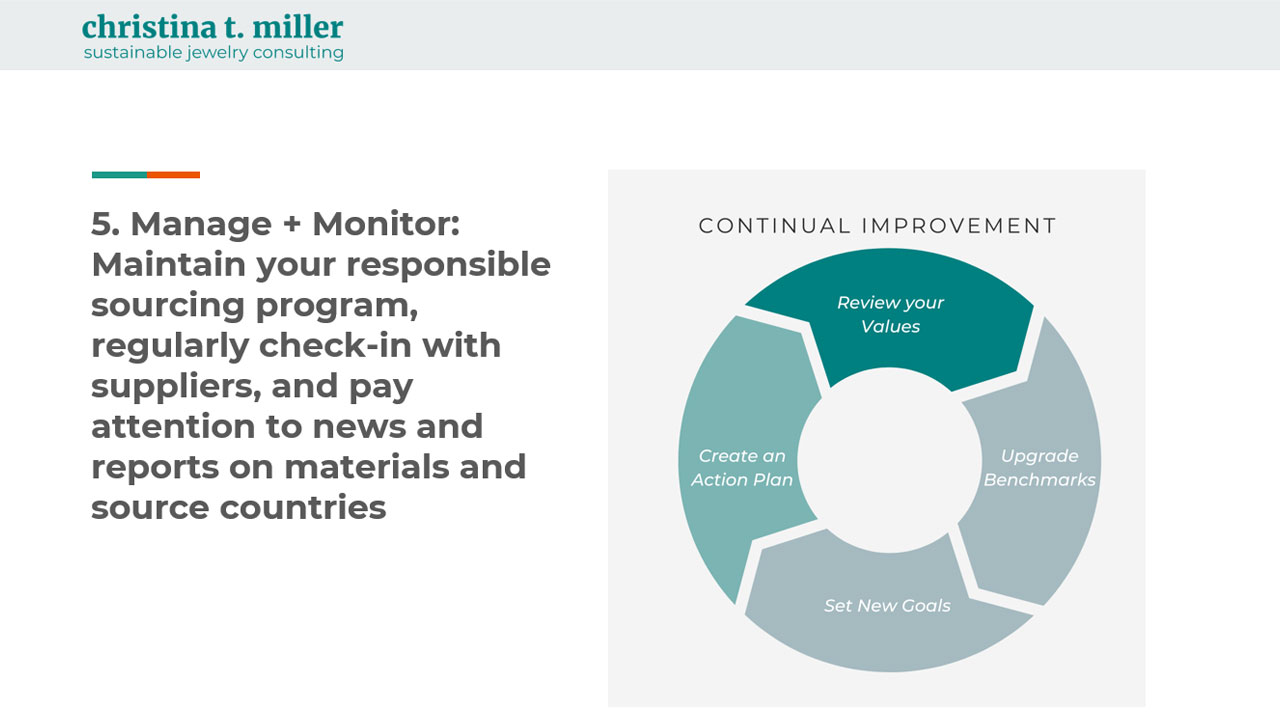
Living Room Session: Back to Basics - Responsible Jewelry Practices
Jun 07, 2022This session aimed to give a bird's eye view of responsible jewelry practices in general and responsible sourcing in particular. It's an introduction to the methodology of Christina T. Miller Consulting (CMC) about starting the journey towards more thoughtful practices.
CMC's responsible sourcing
This approach emphasizes transparency and continual improvement first and foremost. It’s meant to invite your suppliers into the process and encourage their engagement in responsible sourcing, contributing to greater transparency in our supply chains in general. Given that it’s based on continual improvement, your practices will evolve and adapt over time - so regular learning and updates are needed.
The general concept of starting a Responsible Sourcing Program involves the following steps:
- Deciding on your values
- Examining your supply chain and identifying any weaknesses or gaps
- Working with your suppliers and vendors to gain more understanding of how they procure their materials with the goal of identifying where the materials are coming from
- With this information in hand, re-assessing and making any changes if possible
- Continuing to improve over time
1. Identify your values
You start this process by thinking about the type of business you want to become. It’s important to be clear about what you want to accomplish through this process. Adopting an ethical framework is personal because this is your voluntary endeavor, so it's important to know what your personal values are.
Do this by thinking about your core principles, your business values, what you believe in, what you want to be known for. Deciding what these values are will help you clarify what you care about. This will help you stay accountable and guide you in your decision making.
2. Evaluate current practices
After outlining your values, evaluate your suppliers. Take some time to map out your suppliers and vendors. Try laying out your supply chain in a chart so you can have a bird’s eye view. It doesn’t need to be complicated.
You can categorize it into metals, stones, findings & packaging, for example. You can also start with the materials/supplies you use the most. This might mean looking at the expenses you have per material and focusing on the suppliers you invest more money in. This way, you can prioritize these suppliers and put them at the top of your list, instead of tackling all of your suppliers at once.
Do quick research into each supplier, whatever you can find on their website or other sources of information easily at hand. What are they publicly saying about their own business, their materials, and sources? What information have they volunteered about the supplies you’ve purchased from them in the recent past? Also consider what they are NOT saying.

Then, think about the journey of all of the materials you use, from the source to your bench. What information do you know and what don’t you know? How much insight can you get about these suppliers’ practices? What countries do the materials come from? Where are the stones cut?
At this point, you might have 3 to 5 suppliers in your chart with the most important materials each provides you and the information you’ve been able to gather by yourself. This is the start of your own sourcing evaluation, you have begun your own base-line of practices, in other words, your benchmark. From here onward, these benchmarks should progress as you go about improving over time.
Take some time to analyze whether or not your values align with the information you have about your suppliers at this point. This comparison will come in handy once you start talking with your vendors in the next step.
3. Communicating your standards
As soon as you have mapped out your most important suppliers, you are ready to start sharing with them your efforts to become a more responsible jeweler.
This means communicating your values and interest in knowing more about how they procure their materials. You are basically inviting them to help you improve your responsible sourcing practices. You might share an outline of your unique business values and principles and the expectations you have from them in terms of their responsibilities, risks, and actions. You’ll start introducing them to what’s known as your Code of Conduct. The end goal is to encourage your supplier to become involved in the responsible sourcing journey you’re taking and inspire them to start one for themselves, if they haven’t yet done so.
Share your values, your material-specific concerns, and your responsible sourcing goals for your business with them.
4. Make changes
The next step is to make changes. As you start compiling this information, it’s time to take a closer look. Is your supplier willing to listen to your goals and engage in these conversations with you? Even if you got the answer “I don’t know” sometimes, you can now gauge their level of interest in becoming more accountable.
As you begin this journey with your vendors and suppliers, you’ll gain knowledge that will allow you to share with your audience what you can say about your materials and also what you can’t say about them. You can also share what these claims are based on, showing your commitment to due diligence.
How well does the information from your suppliers match up with your principles? Where are the gaps? Which areas are lacking key information?
And now you might be thinking, how do you make a decision? If you’re about to make a large purchase of some material for example, what impact do you want that purchase to have? You’re voting with your dollars. If you’re dealing with a supplier that doesn’t want to change you can escalate the complaint to the community of concerned jewelers, like this one right here. Your responsibility is to ask and apply critical thinking, but you can only do so much as an individual, so we’re lucky to have organizations where we can share our concerns.
5. Manage and monitor
As you continue to improve your sourcing, keep your values as guard-rails, identify more progressive benchmarks, determine new goals, and create action plans to further monitor and implement practices.

Choose a data management tool appropriate for your business, according to size and budget, for keeping track of supplier information. Your current inventory system may support this. Or you might keep it in Google docs, Airtable, an Excel spreadsheet, whatever is easier for you. The idea is to build this responsible sourcing practice into your business operations. Just like you have routines for marketing and sales, this can become a new business habit. You could do this in conjunction with your inventory management, for example. Start where you are and remember to document it well.
Set a 1-3 or 5-year plan to drive your responsible sourcing program forward, one material at a time. Determine as you go along the criteria you’ll use to decide which suppliers to keep an eye on. Create a schedule for checking in with them, especially if you have concerns or are monitoring a particular request for information. If you have the capacity, keep up with news coming from countries/regions you source from and reach out to peers to compare notes. Setting up some Google alerts might help.
6. Promote your efforts and institutionalize continuous improvement
You’ve amassed all this information, now you can begin to confidently share iwith your customers and in your marketing materials. You might share the things that you know and also what you don’t know.
Transparency is built on honesty and humility. Communicate as much or as little as you feel comfortable, there is not one right way to do it. Try to be mindful of the words you use, to make sure you’re not exaggerating or misrepresenting something.
And last but not least, after we have our values, have begun evaluating our suppliers and making some hard decisions, we need to continue to further our impact. And you have support to do this! Reach out for help - this industry has great organizations that are eager to help. You can become a member, join webinars and conferences, reach out to peers on social media.
Always remember that our fellow miners, lapidary artists, and others in source countries are trying to make a living just like us, want the best for their children, and wish to have their own dreams come true. They need and deserve our engagement in responsible practices to lift this whole industry up and forward.
Join Our Community
Stay up-to-date with our latest content, industry news, and more.
Check your Inbox/Junk folder to confirm you want to receive emails from us. Don't worry, your information will not be shared.

